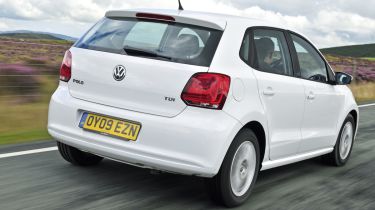VW Polo SE 1.6 TDI 75
With a classy look inspired by the Golf, and the promise of wallet-friendly costs, new car aims to regain supermini crown
Evolution, not revolution, was clearly the watchword for Volkswagen’s designers. The firm was never going to take any risks with the styling of the latest Polo, and the result is as conservative as they come.
With its unmistakable VW face and solid proportions, the newcomer looks like a shrunken Golf. It is longer, wider and lower than the model it replaces, and its thin, horizontal grille, swept-back headlights and more pronounced arches give it a leaner appearance than before.
Video: watch CarBuyer's video review of the VW Polo
[[{"type":"media","view_mode":"content_narrow","fid":"68451","attributes":{"alt":"","class":"media-image"}}]]
There are no surprises inside, either; the quality dashboard and driver-friendly layout are exactly what you’d expect from the firm.
There’s a superb range of seat and steering wheel adjustment, while the audio and ventilation controls are located high up and within easy reach.
With the same white-backlit dials as in the Golf and decent soft-touch materials, the upper part of the Polo’s cabin has a classy feel.
But you get a plastic steering wheel as standard. Moving downwards, the materials are no better than those in the Fiesta. And while build quality is excellent, this is also true of the Ford and Mazda.
Despite having the shortest wheelbase of our quartet, the VW provides good rear legroom, while its 280-litre boot capacity trails the Fiesta’s by only 15 litres.
This small margin is unlikely to make a lot of difference day-to-day, but there is more cause for concern at the front end.
Start up the 1.6-litre TDI motor and you’ll hear a clatter from under the bonnet. Even though the car is all-new, our noise meter indicated
that externally at idle it was 10dB louder than the Ford. Decent soundproofing means this is less obvious on the inside, though, and once on the move things do improve. In fact, excellent wind noise isolation resulted in the Polo being the quietest car here at 70mph.
Less easy to hide is the diesel’s lethargic nature. The TDI is slow to rev and its power delivery lacks urgency.
With only 74bhp and 195Nm of torque – the Ford delivers 88bhp and 200Nm – our VW sprinted from 0-60mph in 14.3 seconds. That’s 2.3 seconds slower than the Fiesta.
In-gear pace is also sluggish. Long ratios and the heaviest kerbweight here meant 50-70mph in fifth took 13.6 seconds. That’s nearly five seconds down on the Ford, and all three rivals felt quicker.
The more expensive 88bhp variant would undoubtedly fare much better, but the lazy throttle response below 2,000rpm and the poor refinement take the edge off our less powerful version.
Even its five- speed gearbox is a major disappointment – it feels the same as the one fitted to the outgoing model and has a reluctant shift that is far removed from the snappy action of the Mazda or Ford.
Unfortunately, the handling does little to bring a smile to your face, either.
While the Polo is safe and undramatic, it can’t match the poise and precision of the Fiesta. Its responses seem muted and slow, with more body roll and less front-end grip.
Crucially, the VW’s ride comfort isn’t perfect, either. It isn’t as firm as the Mazda’s, but neither does it iron out imperfections in the same accomplished way as the Fiesta.
Ultimately, all our testers agreed that motorway surfaces were best dealt with by the Renault.
On the plus side, the Polo feels as solid and reassuringly well built as ever.
Also, stability control is standard across the range, although curtain airbags are an expensive £550 option.
So, the new VW is a step forward from its predecessor – but is it enough of a leap ahead to rise to the top of this toughest of segments?
Details
Chart position: 4
WHY: Polo needs to raise its game, and all-new model looks the part with scaled-down Golf styling and a prestige image.







